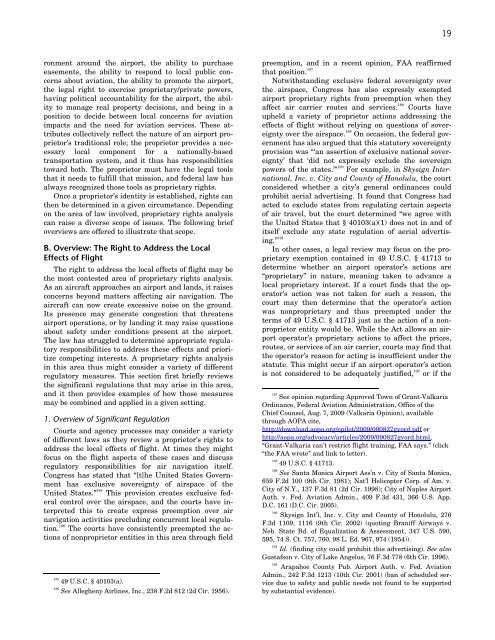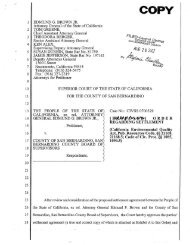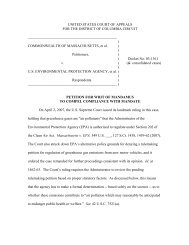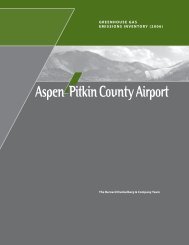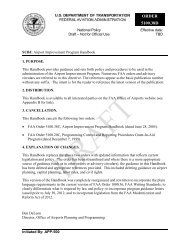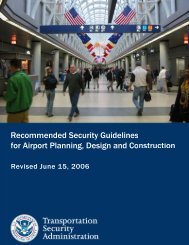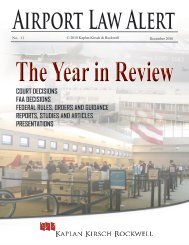ACRP Legal Research Digest 10
ACRP Legal Research Digest 10
ACRP Legal Research Digest 10
You also want an ePaper? Increase the reach of your titles
YUMPU automatically turns print PDFs into web optimized ePapers that Google loves.
19<br />
ronment around the airport, the ability to purchase<br />
easements, the ability to respond to local public concerns<br />
about aviation, the ability to promote the airport,<br />
the legal right to exercise proprietary/private powers,<br />
having political accountability for the airport, the ability<br />
to manage real property decisions, and being in a<br />
position to decide between local concerns for aviation<br />
impacts and the need for aviation services. These attributes<br />
collectively reflect the nature of an airport proprietor’s<br />
traditional role; the proprietor provides a necessary<br />
local component for a nationally-based<br />
transportation system, and it thus has responsibilities<br />
toward both. The proprietor must have the legal tools<br />
that it needs to fulfill that mission, and federal law has<br />
always recognized those tools as proprietary rights.<br />
Once a proprietor’s identity is established, rights can<br />
then be determined in a given circumstance. Depending<br />
on the area of law involved, proprietary rights analysis<br />
can raise a diverse scope of issues. The following brief<br />
overviews are offered to illustrate that scope.<br />
B. Overview: The Right to Address the Local<br />
Effects of Flight<br />
The right to address the local effects of flight may be<br />
the most contested area of proprietary rights analysis.<br />
As an aircraft approaches an airport and lands, it raises<br />
concerns beyond matters affecting air navigation. The<br />
aircraft can now create excessive noise on the ground.<br />
Its presence may generate congestion that threatens<br />
airport operations, or by landing it may raise questions<br />
about safety under conditions present at the airport.<br />
The law has struggled to determine appropriate regulatory<br />
responsibilities to address these effects and prioritize<br />
competing interests. A proprietary rights analysis<br />
in this area thus might consider a variety of different<br />
regulatory measures. This section first briefly reviews<br />
the significant regulations that may arise in this area,<br />
and it then provides examples of how those measures<br />
may be combined and applied in a given setting.<br />
1. Overview of Significant Regulation<br />
Courts and agency processes may consider a variety<br />
of different laws as they review a proprietor’s rights to<br />
address the local effects of flight. At times they might<br />
focus on the flight aspects of these cases and discuss<br />
regulatory responsibilities for air navigation itself.<br />
Congress has stated that “[t]he United States Government<br />
has exclusive sovereignty of airspace of the<br />
United States.” 185<br />
This provision creates exclusive federal<br />
control over the airspace, and the courts have interpreted<br />
this to create express preemption over air<br />
navigation activities precluding concurrent local regulation.<br />
186<br />
The courts have consistently preempted the actions<br />
of nonproprietor entities in this area through field<br />
185<br />
49 U.S.C. § 40<strong>10</strong>3(a).<br />
186<br />
See Allegheny Airlines, Inc., 238 F.2d 812 (2d Cir. 1956).<br />
preemption, and in a recent opinion, FAA reaffirmed<br />
that position. 187<br />
Notwithstanding exclusive federal sovereignty over<br />
the airspace, Congress has also expressly exempted<br />
airport proprietary rights from preemption when they<br />
affect air carrier routes and services. 188<br />
Courts have<br />
upheld a variety of proprietor actions addressing the<br />
effects of flight without relying on questions of sovereignty<br />
over the airspace. 189 On occasion, the federal government<br />
has also argued that this statutory sovereignty<br />
provision was “‘an assertion of exclusive national sovereignty’<br />
that ‘did not expressly exclude the sovereign<br />
powers of the states.’" 190<br />
For example, in Skysign International,<br />
Inc. v. City and County of Honolulu, the court<br />
considered whether a city’s general ordinances could<br />
prohibit aerial advertising. It found that Congress had<br />
acted to exclude states from regulating certain aspects<br />
of air travel, but the court determined “we agree with<br />
the United States that § 40<strong>10</strong>3(a)(1) does not in and of<br />
itself exclude any state regulation of aerial advertising.”<br />
191<br />
In other cases, a legal review may focus on the proprietary<br />
exemption contained in 49 U.S.C. § 41713 to<br />
determine whether an airport operator’s actions are<br />
“proprietary” in nature, meaning taken to advance a<br />
local proprietary interest. If a court finds that the operator’s<br />
action was not taken for such a reason, the<br />
court may then determine that the operator’s action<br />
was nonproprietary and thus preempted under the<br />
terms of 49 U.S.C. § 41713 just as the action of a nonproprietor<br />
entity would be. While the Act allows an airport<br />
operator’s proprietary actions to affect the prices,<br />
routes, or services of an air carrier, courts may find that<br />
the operator’s reason for acting is insufficient under the<br />
statute. This might occur if an airport operator’s action<br />
is not considered to be adequately justified, 192<br />
or if the<br />
187<br />
See opinion regarding Approved Town of Grant-Valkaria<br />
Ordinance, Federal Aviation Administration, Office of the<br />
Chief Counsel, Aug. 7, 2009 (Valkaria Opinion), available<br />
through AOPA cite,<br />
http://download.aopa.org/epilot/2009/090827gvord.pdf or<br />
http://aopa.org/advocacy/articles/2009/090827gvord.html,<br />
“Grant-Valkaria can’t restrict flight training, FAA says.” (click<br />
“the FAA wrote” and link to letter).<br />
188<br />
49 U.S.C. § 41713.<br />
189<br />
See Santa Monica Airport Ass’n v. City of Santa Monica,<br />
659 F.2d <strong>10</strong>0 (9th Cir. 1981); Nat’l Helicopter Corp. of Am. v.<br />
City of N.Y., 137 F.3d 81 (2d Cir. 1998); City of Naples Airport<br />
Auth. v. Fed. Aviation Admin., 409 F.3d 431, 366 U.S. App.<br />
D.C. 161 (D.C. Cir. 2005).<br />
190<br />
Skysign Int’l, Inc. v. City and County of Honolulu, 276<br />
F.3d 1<strong>10</strong>9, 1116 (9th Cir. 2002) (quoting Braniff Airways v.<br />
Neb. State Bd. of Equalization & Assessment, 347 U.S. 590,<br />
595, 74 S. Ct. 757, 760, 98 L. Ed. 967, 974 (1954)).<br />
191<br />
Id. (finding city could prohibit this advertising). See also<br />
Gustafson v. City of Lake Angelus, 76 F.3d 778 (6th Cir. 1996).<br />
192<br />
Arapahoe County Pub. Airport Auth. v. Fed. Aviation<br />
Admin., 242 F.3d 1213 (<strong>10</strong>th Cir. 2001) (ban of scheduled service<br />
due to safety and public needs not found to be supported<br />
by substantial evidence).


